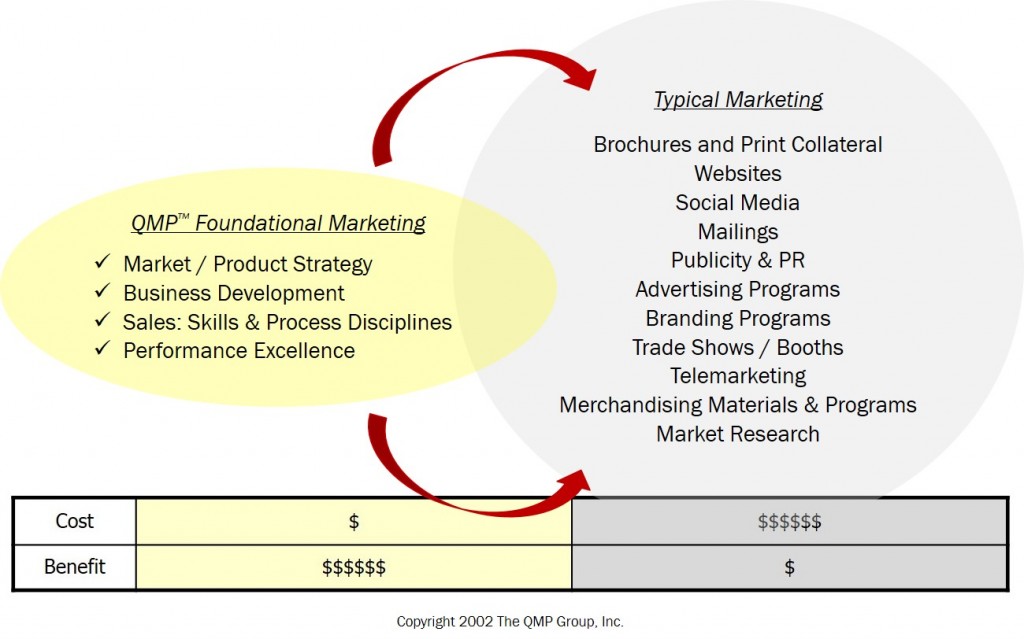Aristotle, (though some attribute it to Mary Poppins), is purported to have said, “Well begun, is half done”. We’ll stipulate that neither Ari or Mary were talking to a group of consultants, or consultative sales folks, but consultant types quickly learn that early preparation can make a big difference in their ability to achieve a client success.
Beginning well requires quickly determining whether all the key ingredients of a “complete” success even exist. These ingredients include; 1) a client executive that has the personality to affect organizational change, 2) the potential of a major economic benefit for the client, 3) a style match of the consultant to the culture of the client organization and 4) solid gains beyond just your fee, for you, the consultant.
The Executive Personality Factor:
Early in their careers consultants learn that project success is rarely generated solely from their own catalytic, outside-in efforts. Every success needs internal collaboration with a client executive to affect change, assure  execution and sustain the economic benefit of a project beyond the engagement.
execution and sustain the economic benefit of a project beyond the engagement.
Recognizing the critical role the lead executive plays in client success, we conducted an analysis of the last ten years of QMP engagements. We wanted to discover the earliest predictors of success from personality-reads on the lead executive. Why did we do this? Because, not all engagements are “complete” successes, and we recognized that achieving a complete success significantly multiplied the economic benefits for both us and our clients.
That analysis brought us to this conclusion:
“The personality type of the highest client executive involved in a specific consulting engagement, not simply his title or position, is the best predictor of an engagement’s ultimate success and the longevity of economic benefit received by both the client and the consultancy practice”
In your career, you may have participated in any of the myriad of commonly practiced personality profiling exercises. Myers-Briggs may have awarded you the distinction of an ENTJ or ISFP. Another test may have designated you a color personality, such as an Orange, or in the DISC profiling system, labeled you an “S”.
While self-knowledge is valuable, it’s not likely you will be able to ask your clients to subject themselves to a battery of personality tests before you provide them a proposal or start an assignment. So the problem remains. How can one identify client types and predict success from the earliest discussions? How can one know when to stay and when to run?
Sorting through hundreds of transactions resulted in our Approach-to-Business (ATB) scale for classifying executives. Admittedly, it wasn’t the most scientific of studies. We don’t have a research psychologist on staff. We simply sorted and grouped like-client individuals, named the groups and then regrouped by project success.
The grouping resulted in eight categories. Only three of the types seemed to have the key success gene, which we identified as the ability and courage to drive change.
So that this last point is not lost, it deserves mentioning again. The key factor in the successful types is their ability to manage and execute organizational change. In our experience, all types will say they are prepared to affect change but only three types actually do.
It’s Not the Title, It’s the Type
It is common to hear among consultants that “executive buy-in” is essential for engagement success. Our data refuted the generality of that claim. We restate it this way, “buy-in from executives at the right level and of the right ATB types is essential for success”. To truly be valuable in generating success, executives must be both the right ATB type and high enough in the organization to marshal resources and get attention when needed.
We have tested our ATB classification with consultants from around the country. They almost universally and immediately, recognize their own current and prospective clients among the types – as well as their project and proposal successes and failures. Once the patterns of these ATB personality types are recognized, one can adjust tactics, refocus resources appropriately and save an enormous amount of time while increasing the probability of “complete” success.
The 8 Client ATB Personality Types:
STUMPs: STUck in the Mud People will never change, they will never buy. They have a limited point of view and don’t move very far from it. Even if you are convinced, beyond any doubt, that they need your help and could reap enormous benefit, it is irrelevant. They are simply disinclined to buy professional services. Don’t try to convince or educate them, because they really don’t care. Politely walk away. Don’t persist. Unsolicited proposals will simply frustrate you, while bemusing them. It’s futile.
Takers: Takers know how to take. They take great notes, your time, your materials, your ideas, your concepts, and turn them into their own. They use your materials surreptitiously, under the radar. Credit or compensation for your ideas? What ideas?
Imagine having your third meeting with a client who appears to be interested, has taken a lot of notes but little or no action. Now, imagine the time and frustration you could have saved had you known from the outset that this potential client was a Taker. These prospects are experts at appropriating concepts and ideas, often asking during preliminary discussions if they can have copies of some of your key documents “to review with their people”. Don’t go there.
Opportunists: Opportunists want to purchase the minimum, bare bones package of services. Their hope is that purchasing the minimum will generate great results. Their expectation is first class results for the “economy” investment. Follow-through to success is rare, since they don’t have the expertise required to execute. Quite often the Opportunist will start many small projects. They will lose interest quickly if results are not immediate or if it seems like too much effort.
Boss-Made-Me-Do-Its: BMMDI’s (pronounced “Bim-Me-Dees”) are the political hangers-on of the corporate world. They provide lip service and public support for an improvement initiative but usually have little sincere enthusiasm—particularly if the consulting assignment has the likelihood of revealing and correcting weaknesses in their own department or function. They will engage, but only long enough to satisfy the boss. If the boss’ attention goes elsewhere, the engagement will die on the vine – as will success.
BMMDI’s have no personal commitment or belief. They may even engage in “lipotage” – public lip service, followed by indifference, or worse, sabotage. (The word “lipotage” was coined by my colleague Bob Phillips and co-author Larry Johnson in their book “Absolute Honesty” published by AMACOM Press).
A particularly hopeless combination is a BMMDI with an Opportunist boss.
Terribly Troubled: TT’s really need help and are willing to invest in serious solutions. Their level of pain is high, as is their motivation to fix the problem. They may research alternatives, but will make a decision quickly. They are typically in a rush to get started and consequently may miss some alternatives – but they will move forward. Spend quality time with these prospects to ensure they understand what will be done (deliverables), what’s required for success (commitment) and how you will fix the problem (approach).
Frustrated Drivers: FD’s can be very intense and quick in studying alternatives. Many times these are executives that inherited a family business or took over after a long oppressive or “old-fashioned” leader – perhaps a StuMP.
They have been waiting a long time for the opportunity to straighten things out. Their drive and motivation is high. They usually understand the weak points, the resources and commitment needed and, upon decision, will drive for quick, visible results.
Establishing well-defined goals, benchmarks, checkpoints and progress measurements will help FDs satiate their sense of urgency. Communicate frequently, clearly and succinctly. Emphasize speed, drive for quick traction and show results.
Sincerely Growth-Oriented (SGO): SGOs are there for the long term. These are clients that readily recognize they have issues and challenges, and demonstrate a sincere and strong desire to improve. An ideal type of client, they understand performance excellence and are motivated by it. They thrive on achieving goals and are constantly improving basic business processes. They are the best-of-the-best clients, intellectually, emotionally and financially. If you consistently provide high value to them in your engagements, SGOs will remain loyal for a long time and continue to award you new projects and referrals.
Dreamers: Imagine Don Quixote, the idealist and self-imagined white-knight savior. Dreamers are lofty in their vision and motivation, perhaps even charismatic, yet impulsive and occasionally misdirected. They are typically challenged at getting organizational buy-in and support, based on a history of failed past initiatives. Their grandiose visions of the corporate future are rarely realized. They talk enthusiastically but show little interest in getting deeply involved in the details of execution .
According to our research, Terribly Troubled (TT’s), Frustrated Drivers (FD’s) and Sincerely Growth Oriented (SGO’s) generate the most meaningful successes by an order of magnitude, in terms of the highest long-term value for all concerned.
But wait! Good ATB genes are required, but not sufficient.
ATB considerations create opportunities for complete success only if the three other raw ingredients exist as well.
Ingredient #1: Strong Economic Benefit:
Business-to-business executives buy consulting services because of a basic belief that the money invested in those services will return significantly greater economic value than the cost. If there isn’t a meaningful economic benefit to be achieved for the client, com “complete” success may end up a ‘Pyrrhic” success.
Ingredient #2: Consultant Style, Capabilities and Personality
These ingredients must Blend with the Client’s Culture: Clients want a consultant whose expertise is well-matched to their specific needs. Furthermore, the ideal client relationship must be based on mutual trust and open communication. But even with these factors covered, execution remains the biggest challenge, because the people in the organization must change the way they do things.
The ability to affect change is enhanced with good communication – and communication is most effective when the consultant’s personality and style match the personality, style and culture of the client organization.
Ingredient #3: Wins for the consultant:
Beyond the economic payoff, other rewards await a complete success: case studies, new tools and techniques, raw material for articles, referrals, follow-on business and new networking connections. If you are going to invest the next six months in a major client engagement, it’s better to find one of that holds the promise of the multiple rewards of a “complete” success.
Personality to Profit
A consistent challenge in selling consulting services to a new client is getting an audience at the right executive level. It is a coup. But when the actual discussion starts, it is common to get so focused on the problem at hand that one can easily forget to look for all the key ingredients of success.
We started this article with a quote from Aristotle, so it’s only fitting to end with a quote from the great American philosopher, Yogi Berra. Berra is purported to have said, “You can observe a lot, just by watching”. Let me add this, “..but you must remember to observe.”
*****
Learn more about the QMP process for reading people and creating winning sales strategies in our one-day Sales Skills and Process Training Workshop, 60/90 minute on-line Sales Webinars or, for consultants, our Consultancy Navigator program. If you have special need let us know of them through our Contact Us page, or call us at 503.318.2696.












